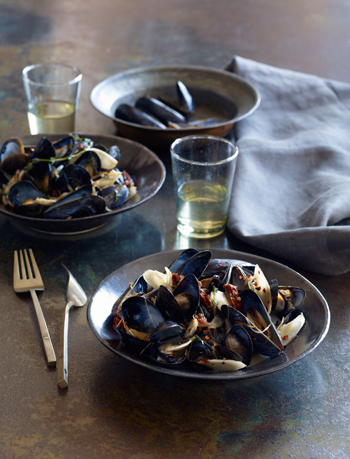During the spring, summer, and fall, many of us journey to our weekly farmers markets where we often encounter new ingredients. Sometimes unfamiliar foods stump us, and we wonder how to cook gnarly things often they are some sort of root vegetable. When we heard about a new book, called just Roots, we could not wait to dig in and start reading!
With twenty-eight chapters, arranged alphabetically by vegetable, complete with the history, lore, and nutritional information on each and 225 recipes, you can surely see how this book can call itself the definitive compendium of roots!
The book is not only deeply informative but it is beautiful, filled with phenomenal photography to help readers give each root a visual identity. But enough of us talking about the book. We have some insights straight from the author herself.
OLDWAYS: Diane, for those who may not know about all your work (freelance writer, author of seventeen books, culinary instructor and restaurant consultant) can you talk to us about how you came to write Roots
DIANE: The idea for the book was spurred by a trip to the farmers market a regular Saturday morning ritual for me. It was about two weeks before Thanksgiving and I was shopping for winter greens, butternut squash for soup, and celery root. I was holding my market bag on my arm and selecting three large celery roots to make a gratin. A woman stopped me and asked about the roots, not knowing what they were and also commenting on how ugly they were. I enthusiastically described the root and how delicious it was and versatile for cooking or even eating raw in salads. I bought my roots and she walked away. At my next stop, a few stalls up, I stopped and picked up a long, stick-like root, turned to the farmer, and asked, What is this
He eagerly responded, Oh, that is burdock root. Have you ever tried it I had not.
As I walked back to my car I started thinking about this circular story. A woman asks me about celery root, a root unfamiliar to her, and I turn and ask a farmer about burdock root, a root I didn’t know. It got me thinking about root vegetables.
I spent several hours that afternoon searching through my cookbooks to learn about roots. I wanted to know what vegetables comprised the family of roots, what were interesting recipes using roots, and their nutritional value. It took a slew of cookbooks to gather some, but not all the information I was looking for. Later in the week, I went to the library and a bookstore in Portland devoted to cookbooks and gardening books to research more. I realized the book I wanted to own did not exist. I wanted a singular book that contained the complete family of root vegetables. Beyond that, I wanted information on what to look for when shopping for roots, how to store and prepare them, their seasonality, and lots of recipes for each root that would exploit its goodness.
In the end, and for very selfish reasons, I wrote the book I wanted to own.
OLDWAYS: The book presents so many fascinating facts! One is that the basic definition of a root isn’t so basic. Can you help our readers gain a better botanical perspective of roots
DIANE: I felt like I needed a complete course on botany just to understand the family of roots. As an undergraduate, I studied mathematics not biology, so I did quite a bit of self-study in order to understand what defined a root vegetable. We think of roots as say, carrots or beets, which are taproots. That is, the main root of the plant that absorbs nutrients and moisture as it grows vertically downward. Taproots vary in shape; just think of beets versus parsnips, salsify and radishes.
Beyond that, there are tuberous roots, such as sweet potatoes, and stem tubers, such as potatoes and Jerusalem artichokes. Included in the family of roots are rhizomes and corms. Ginger, turmeric, and wasabi among others, are good examples of rhizomes. Water chestnuts and taro are two examples of corms. Finally, there is the Allium family (bulbs), such as onions, shallots, and garlic. While corms have a solid interior, bulbs have fleshy layers. We can compare the tissue layers of a shallot (bulb) with the solid heart of a water chestnut.
OLDWAYS: You mention that you made a deliberate decision to keep the focus away from Allium, the onion family of subterranean root buds. Does that mean we will be lucky enough to learn more about these particular roots in a forthcoming book
DIANE: To clarify, I did not include the Allium family in my book. The scope of the book was growing by leaps and bounds without the bulbs included. Had I included them, I would have had fewer recipes for each root and that wasn’t what I wanted. While I did allude to the idea that the Allium family would have to wait for another project, I am not convinced that is my next book to write. I’m still rooting around on that idea!
OLDWAYS: A root cellar in every home would be ideal, but for those who may not have the space or are just not ready start burrowing in their backyard, do you have some conventional handling techniques to help readers keep their roots radiant (and edible) for as long as possible
DIANE: Root cellars were the low-tech cold-storage system for preserving the harvest. That all changed with the invention of the refrigerator. I keep roots for months in the crisper bins of my refrigerator. I wrap each root or bunch of roots in a dry paper towel and store them loosely wrapped in a plastic bin inside the bins. The paper towel wicks away trapped moisture, which begins to rot the root over time. I have kept parsley root and celery root for several months in the refrigerator.
Portland, Oregon, where I live, is reasonably temperate in the winter, so keeping roots in a protected spot in the garage isn’t cold enough for storage. In colder climates, where an attached garage might get cold but not dip into freezing temperatures, bins or heavy boxes filled with sawdust or newspapers will mimic a root cellar for prolonged storage of root vegetables.
OLDWAYS: One of the roots that caught my attention was burdock never mind that I had no idea those prickly burs that stick to you in the woods are attached to edible roots. And then to and out that they are also the inspiration behind Velcro was too much! In your research did a particular root rise to the surface as your favorite Why
DIANE: I’ve been asked this question on several occasions and it feels like being asked which is my favorite child! All of the roots are unique and each offers up such varied flavors and ways to prepare them. While beets and celery root rank high on my favorites list because they are delicious in both raw and cooked forms, I then begin to think about the versatility of the humble potato, or the pronounced tastes from the flavoring roots such as horseradish, ginger, galangal, and turmeric. From there, I get excited about the global roots I learned to love, such as malanga, yuca, and true yams. These roots let us move into the international kitchen to cook from Latin American and Asian cuisines. We can pick up a cookbook on Thai cooking and understand the importance of coriander root or fresh turmeric to that cuisine. How exciting is that!
OLDWAYS: We would love to include one of your recipes on our blog. Is there one you might suggest
DIANE: Since you mentioned burdock root, and this root became a new favorite in the course of writing the book, I think your readers might enjoy the recipe for Steamed Mussels with Burdock Root, Shallots, and Sun-Dried Tomatoes. While exploring the wonders and textures of burdock, I discovered that mussels and burdock pair beautifully, and developed this recipe for the book.
Steamed Mussels with Burdock Root, Shallots, and Sun-Dried Tomatoes
As it turns out, mussels and burdock root are a natural pairing, delivering an incredibly savory, briny flavor to this dish a true umami taste. Buy fresh, sweet, plump mussels from a trusted fish purveyor. Once home, spread them out in a large, shallow baking dish, cover them with damp papers towels and then loosely with plastic wrap, and refrigerate until ready to use. I always scrub and debeard the mussels right before I steam them. While you are shopping, buy a loaf of crusty bread for sopping up the delicious sauce.
Serves 3 as a main course, 4 to 6 as a first course
Ingredients:
2 tablespoons unsalted butter
4 oz/115 g burdock root, scrubbed, trimmed, and cut on a sharp diagonal into slices in/3 mm thick
¾ cup/85 g thinly sliced shallots
½ cup/55 g drained oil-packed sun-dried tomatoes, blotted dry and cut lengthwise into thirds
2 fresh thyme springs
1 teaspoon kosher or one sea salt
¼ teaspoon red pepper flakes
2 lb/910 g mussels, scrubbed and debearded
1 cup/240 ml dry white wine
¼ cup/60 ml heavy whipping cream
Directions:
In a large, deep frying pan with a tight-sitting lid, melt the butter over medium heat and swirl to coat the pan bottom. Add the burdock root and shallots and sauté, stirring frequently, until the shallots just begin to turn golden brown, 3 to 5 minutes. Add the sun-dried tomatoes, thyme, salt, and red pepper flakes and sauté for 1 minute longer. Increase the heat to medium-high and add the mussels and wine. Cover and cook until all of the mussels have opened, about 5 minutes.
Uncover the pan and add the cream. Give a quick stir to blend it in, then bring the liquid to a simmer and remove from the heat. Divide the mussels and cooking liquid among warmed bowls, discarding any mussels that failed to open. Serve immediately.








Leave a comment